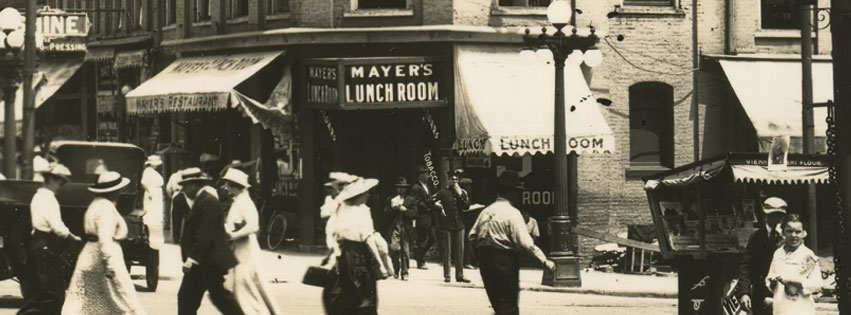
I’ve been pondering food—and the locations where Peorians consumed it—over the last few weeks. I originally intended this piece to be a retrospective of homegrown Peoria eateries, but there have been so many over the years. How does one cram a comprehensive history into 1,000 words? It just can’t be done. So that will have to wait… but that doesn’t mean we can’t take a look at a few famed Peoria “beaneries.” More specifically, I will focus on a handful of places where Peorians ate their lunch in Downtown Peoria—from the 1850s through today.
Segars, Dumbwaiters & Oyster Saloons
In the course of my regular workweek at the downtown Peoria Public Library, I often come across tidbits of information in old newspapers, phonebooks, city directories, photos and other resources regarding restaurants, sandwich shops, cafes, diners and lunch counters. Most have come and gone—many before I was born in 1970. While I have not visited the majority of these establishments nor tasted their fare, I feel like I know them—especially as the lunch hour nears. As my hunger increases, I dream of a time machine that could take me back so I could sample their offerings.
Speaking of time machines: our resources in the Local History & Genealogy Room can take you on a virtual trip through time via the mind’s eye. Browsing city directories of the mid-19th century, you will see advertisements with illustrations and decorative lettering for places like the Telegraph Coffee House on Washington Street, which in 1855 featured “Sardines & Oysters, Game, and Pies”—or the Arcade Eating Saloon on Water Street, which served “Fresh Oysters” and “Warm Meals at all Hours” along with “Segars, Wines, and Liquors” in 1859. During this time period, scores of small commercial buildings lined Peoria’s downtown, which had many individual businesses in a more compact area than it does today.
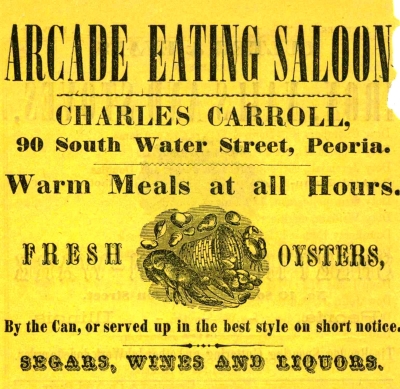
Our records show “oyster saloons” even earlier than the aforementioned, and many of them had separate men’s and women’s dining areas. Oysters were most often served in the basement areas of businesses, where they could be kept colder. These basements also tended to draw a rowdier crowd of men. Restaurateur Louis Furst solved this problem in 1859 when he opened the Eastern Exchange Confectionary, Restaurant and Ice Cream Saloon at the corner of Adams and Hamilton.
Furst’s establishment had a dumbwaiter that brought food up to a separate dining area—“so that a lady without an attendant can at all hours refresh herself from the ample bill of fare and without being inconvenienced by the presence of strangers.” It was further described in a newspaper article as far excelling any other restaurant in Peoria—and eclipsed by few similar establishments west of New York City. Furst’s place had marble tables and a soda fountain, and was stocked with the finest confectioneries and fruits, both foreign and domestic. The two floors were connected by a spiral staircase supplied by a fledgling A. Lucas and Sons. It also had its own wine cellar stocked with the “best that the country could afford.”
The Famed 3-Cent Lunch
Fast forward a few decades to the turn of the 20th century, and you will find a sizeable increase in eating establishments, many catering specifically to the downtown lunch crowd. One local favorite, based upon a newspaper article chronicling its closing in 1930, was Mayer’s Lunchroom, home of the “famed… Mayer’s 3-Cent Lunch.”
Mayer’s was located on the corner of Main and Adams in the block currently occupied by Caterpillar—a central location for drawing a lunch crowd, as it still is today. Nearly every item on the menu cost three cents (slightly less than a dollar in today’s money); a meal consisting of a hamburger, a dish of baked beans, a piece of pie and a cup of coffee could be had for 12 cents. “In the old days it was a popular gathering place for Peoria visitors,” the article states, patronized by several hundred persons every day. Its interior, which was remodeled in 1902 after about 10 years in business, is described as “having the same coffee urn, sideboard and counter that were in place 28 years prior.” The counter was worn deep along the edges, where it was “customary for men to rest their arms while taking on the nourishment of life.”
Mayer’s closed after more than 40 years of service. However, the Mayer family did very well with their theory that “a hungry man would rather eat beans and bacon than caviar and canapés.” According to our records, the business grew to include lunch counters in five other cities, and its profits paid for the building of one of Peoria’s finest hotels, the Mayer Hotel, one block up North Adams.
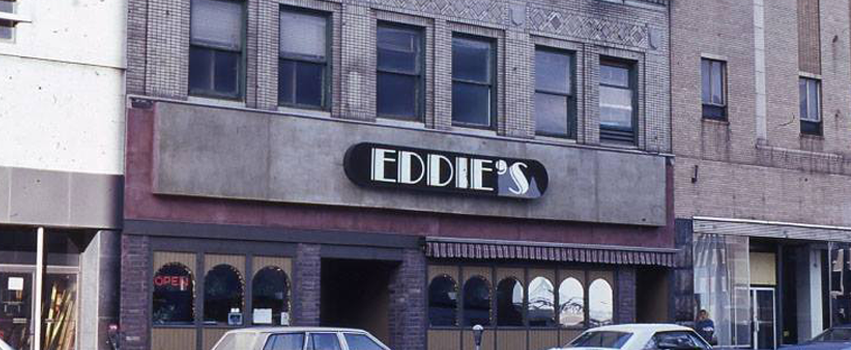
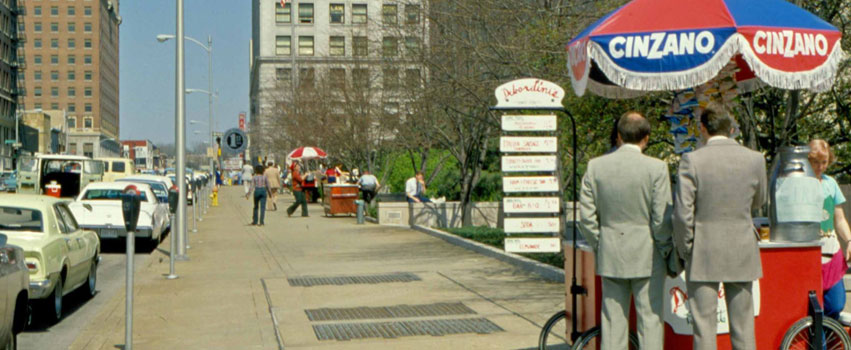
Cycle of Downtown Eateries
While Peoria still has places to eat downtown, the exodus of retail in the 1970s, along with the arrival of lunch carts and nearby fast food options, helped precipitate their decline. One lunch spot that opened as a delicatessen in the early 1980s—even as downtown was reeling from the loss of businesses—was Eddie’s on Adams near Fulton Plaza. In 1984, it became the well-known Sully’s Pub & Café, created by the renowned restaurateur Mike Sullivan, who left his creative imprint on several other Peoria restaurants. Sully’s has sat vacant since 2013, but if you walk by its windows and peer inside today, it appears to be frozen in time. Perhaps when OSF HealthCare’s new headquarters building opens across the street, Sully’s will find new life.
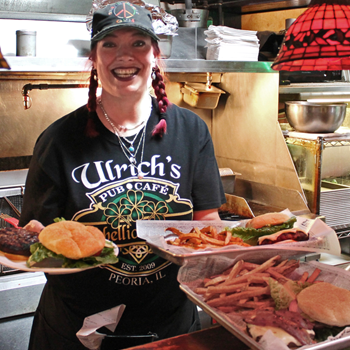
In the meantime, one can still get a sampling of what Sully’s was like at Ulrich’s Rebellion Room in the 600 block of Main Street. Its cozy and inviting interior, for the most part, looks just as it did when Sully designed it approximately 20 years ago. It is now owned by Joe and Jennifer Ulrich, who met while working under Sully when the place was known as Sullivan’s. I can say from personal experience that they serve up some tasty lunch offerings at reasonable prices, albeit only on Thursdays and Fridays. Perhaps the menu’s most popular items—unchanged since the days of Sully—are the hamburger and fries—among the best examples of this can’t-beat combination in all of Peoria.
Spurred by OSF’s investment in the 100 block of SW Adams, Peoria’s downtown may well see a renewed interest on the part of food entrepreneurs catering to the lunch crowd. Joe Slyman owns the Adams Street Café, just a few doors down from Sully’s, proclaimed as the “Oldest Family Owned Café in Downtown Peoria.” It’s a modern-day version of Mayer’s Lunchroom, with a counter, tables and reasonably priced offerings that are always satisfying—especially the homemade deli chips that accompany the various burgers, wraps, sandwiches and paninis.
In my opinion, Slyman’s place is perfectly poised to cater to Peoria’s new lunchtime crowd. The Adams Street Café is in a location historically successful for attracting hungry denizens seeking a quick bite to eat—it’s located almost directly across from where Mayer’s sat 90 years ago. PM
- Log in to post comments

